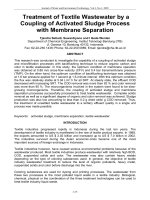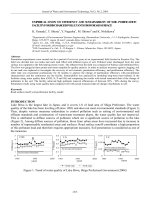A preview of soil behavior
Bạn đang xem bản rút gọn của tài liệu. Xem và tải ngay bản đầy đủ của tài liệu tại đây (2.99 MB, 75 trang )
An Overview
of
Soil Mechanics
Dr. P. K. Basudhar
Dept of Civil Engineering
IIT Kanpur
Soil Problems
&
Solutions
A Preview of
Soil Behavior
Pioneers in
Soil Mechanics
WHERE ?
CIVIL ENGINEER
ENCOUNTERS
• SOIL AS A
– FOUNDATION
– CONSTRUCTION MATERIAL
• SOIL RETAINING
• SPECIAL PROBLEMS
SOIL
FOUNDATIONS
• WHAT ARE FOUNDATIONS?
• TYPES OF FOUNDATIONS
– SHALLOW FOUNDATIONS
– DEEP FOUNDATIONS
• MAIN PROBLEM IN THE DESIGN
– TO PREVENT SETTLEMENT
• TOTAL SETTLEMENT
• DIFFERENTIAL SETTLEMENT
SHALLOW FOUNDATIONS
• Structural loads are
carried by the soil
directly under the
structure
DEEP FOUNDATIONS
• Used to carry
ca y the
t e
loads to firm soil at
p
some depth
Classic case of bad foundation
• Fig.
Figg. shows the Palacio de las
Bellas Artes, Mexico City
• The
2
m
differential
settlement between the street
and the building on the right
necessitated the steps which
were added as the settlement
occurred
• The general subsidence of
this part of the city is 7 m
• (Photograph compliments of
Raul Marsal)
Example of Shallow foundations
• Fig shows the MIT
students centre
• Mat foundation
• Floatation technique
Main Factors
1. Just how deep into the soil should the building be
placed?
2. Would the excavation have to be enclosed by a wall
duringg construction to p
prevent cave
cave--ins of soil?
3. Would it be necessary to lower the water table in
order to excavate and construct the foundation and,
if so,
so what
h t means
me ns should
sho ld be used
sed to accomplish
omplish this
lowering of the ground water (dewatering)?
4. Was tthere
e e a da
danger
ge o
of da
damage
age to adjace
adjacentt b
buildings?
d gs?
5. How much would the completed building settle and
would it settle uniformly?
6. For what stresses and what stress distribution should
the mat of the building be designed?
Example of Deep foundations
• MIT material centre has
deep
pp
pile foundation
• Reasons
– Basement space not
desirable
– No sand and gravel at
the
h site
i
– Not to disturb
underground utilities
• Point bearing pile
• Friction pile
p
• Augering
Main Factors
I What type of pile should be used?
I.
2. What was the maximum allowable load for a pile?
3 At what
3.
h t spacing
p in should
h ld th
the pil
piles b
be dri
driven?
n?
4. How should the piles be driven?
5. How much variation from the vertical should be
permitted in a pile?
6. What was the optimum sequence for driving piles?
7. Would the driving of piles have an influence on
adjacent structures?
Example of Embankment
on Soft Soil
• 10.
10.7 m embankment
on a 9.8m layer of
soft soil
• Preloading technique
• Shear rupture should
not occur
Main Factors
1. How high a fill could be placed?
2. How fast could the fill be placed?
3. What
Wh t were
r the
th maximum
m im m slopes
l p for
f r the
th fill?
4. Could the fill be placed without employing special
t h i
techniques
t contain
to
t i or drain
d i the
th soft
ft foundation
f
d ti
soil?
5. How
H much
h would
ld the
h fill settle?
l ?
6. How long should the fill be left in place in order
that
h the
h foundation
f
d i
b compressedd enough
be
h to
permit construction and use of the tank?
Example of Foundation Heave
• Occurs when foundation soil expands when the
confining pressure is reduced and / or the water content
of the soil is increased
g
• Arid regions
• Presence of montmorillonite
Main Factors
• Proper size ,capacity,
capacity length and spacing of the
piles
• The pile should be long enough to extend below
the depth of the soil that would expand
• The
Th depth
d h selected
l
d in
i such
h a way that
h the
h
confining pressure from the soil overburden
plus
l
minimum
i i
load
l d is
i sufficient
ffi i
to prevent
expansion
CONSTRUCTION MATERIAL
•
•
•
•
Select proper type of soil
Method of placement
Control of actual placement
Fillingg
Example of an Earth Dam
• Two main zones
– Clayy core
– Rock toe
• Gravel filter
• Rock facing
• Zoned earth dam & homogeneous earth dam
Main Factors
I. What should be the dimensions of the dam to give the most
economical, safe structure?
2. What is the minimum safe thickness for the gravel layers?
3. How thick a layer of gravel and rock facing is necessary to
keep any swelling of the clay core to a tolerable amount?
4. What moisture content and compaction technique should be
employed to place the gravel and clay materials?
5. What are the strength and permeability characteristics of the
constructed dam?
6. How would the strength and permeability of the darn vary
with time and depth of water in the reservoir?
7. How much leakage would, occur under and through the dam?
8. What,
Wh if any, special
i l restrictions
i i
on the
h operation
i
off the
h
reservoir are necessary?
Example of a Reclamation Structure
• NonNon-availabilityy of
good building sites
• Harbor and terminal
facilities
• Hydraulic filling
Main Factors
I. How deep should the sheet pile wall penetrate the foundation
soil?
2. How should these piles be braced laterally?
3. What is the most desirable pattern of fill placement i.e., how
should the exit of the dredge pipe be located in order to get
the firmer part of the fill at the locations where the maximum
foundation loads would be placed?
p
4. What design strength and compressibility of the hydraulic fill
should be used for selecting foundations for the tanks,
buildings,
g , and pumping
p p g facilities to be p
placed on the island?
5. Where did the soil fines in the dirty effluent which went out of
the island over the spillway ultimately settle?
Example of Highway Pavement
• Most common use of soil as
constr ction material
construction
• Pavements
– Rigid
– Flexible
Main Factors
1. How tthick
c sshould
o d tthee various
va o s co
components
po e ts o
of tthee
pavement be to carry the expected loads?
p
mixture of additives for
2. What is the optimum
stabilizing the desert sand?
3. Is the desert sand acceptable for the construction of
the wearing surface?
4. What grade and weight of available asphalt make
the
h most economical,
i l satisfactory
if
wearing
i surface?
f ?
5. What type and how much compaction should be
used?
sed?
SLOPES AND EXCAVATIONS
(a) Natural Slope
(c) Excavation for Pipe
(b) Excavation for Building
(d) Canal
UNDERGROUND AND EARTH
RETAINING
T
STRUCTURES
T
T
• Soil
Soil--structure interaction
• Examples
– Pipe
Pi shells
h ll
– Basement walls of the building
– Sheet pile wall
– Tunnels
– Drainage structures
Example of Earth retaining structure
• Anchored bulkhead
• Take care of lateral
stresses
tr
• Stability against shear
rupture









